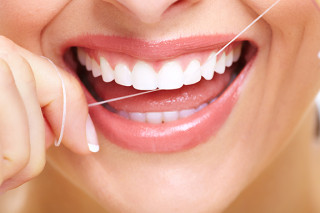Gum Disease – Only Floss The Ones You Want To Keep
“No, I don’t floss, but I’m really good about brushing”
 This is a troubling statement I hear on a daily basis from many of my Rancho Santa Margarita patients. And if the patient happens to not have any new cavities, I can see their confidence growing, perhaps thinking, “My brushing must be so good I don’t even need to floss.”
This is a troubling statement I hear on a daily basis from many of my Rancho Santa Margarita patients. And if the patient happens to not have any new cavities, I can see their confidence growing, perhaps thinking, “My brushing must be so good I don’t even need to floss.”
While, flossing will certainly reduce a person’s risk for cavities, that’s not the only reason your dentist wants you to be diligent with your oral hygiene practices.
As we chew our food our teeth are designed to lean against each other, keeping the majority of food from getting stuck in-between. This by no means keeps everything from getting in between. Some people have bigger spaces than others, and some foods just stick a little more than others.
So there you are, you’ve just eaten and you have a little food in the space in between your teeth. Not even thinking about the obvious particles you can see, there are tiny particles that sit just below the gum level that you might not even know are there, and that brushing alone will not remove.
“Well, I don’t have any cavities,” you may be thinking. That’s good, but that’s not the only issue. The spaces in between those teeth that catch food down in the gums are called gingival pockets. These pockets, when healthy, are between 1-3 mm deep. That’s not very deep, and it’s easy to clean them with daily flossing. When you don’t floss, however, the particles left there are called plaque. Left to build up the plaque hardens and becomes calculus. Not only is calculus too hard to remove with just normal flossing, it is also very irritating to the gums. It can cause gums to become red and puffy, and occasionally bleed when flossing or brushing. This is called gingivitis. Gingivitis can be annoying but it is completely reversible with a good professional dental cleaning and improved home care.
Red And Puffy Gums
When left unchecked though, those red and puffy gums will start to recede away from the irritating calculus in the only direction available — down.
As gums recede, we see a couple of other problems arise. First, is cosmetic – as more of the tooth surface is exposed you may notice you no longer have that even “Hollywood smile.” That is because as gums recede some of the root surface becomes exposed making the tooth look longer. In addition to this, that portion of root that you can see is not as hard as your enamel. That means the tooth is now susceptible to sensitivity to hot and cold, as well as erosion from brushing a bit too hard or eating and drinking acidic foods.
Second, as the gums recede, the bone in your jaw follows. This means you have less bone holding onto the tooth and those pockets that were 2 or 3 millimeters deep are now 5 or 6 millimeters. And just like that, you have developed gum disease (also known as periodontal disease). Now you are even more likely to get plaque buildup in those deeper pockets but the difference is now that the pocket is twice as deep as it should be, it is much more difficult, if not impossible, for you to clean it at home with regular flossing. Now you may need a scaling and root planing at the dentist’s office (also known as a deep cleaning) in order to bring your gums back to a healthy state.
At this point you are at a crucial crossroads. Untreated, the periodontal disease will continue to cause bone loss and deeper pockets, leading to a cycle of more calculus buildup and more bone loss until there is almost no bone left surrounding the tooth, making it loose to the point where you end up losing the tooth.
Treating Gum Disease
Or you can treat the problem by getting a deep cleaning at a dental office, returning for regular checkups and cleanings, and flossing and brushing at home. Treatments for more severe cases range from antibiotic medicine placed directly into the pockets or even gum surgery.
Of course, preventing periodontal disease is much easier than treating it. So no matter how often you brush, be sure to save some time before bed to floss. Your gums will thank you!
Contact Us
For more information about gum disease or how our doctors can help youcontact us today.


